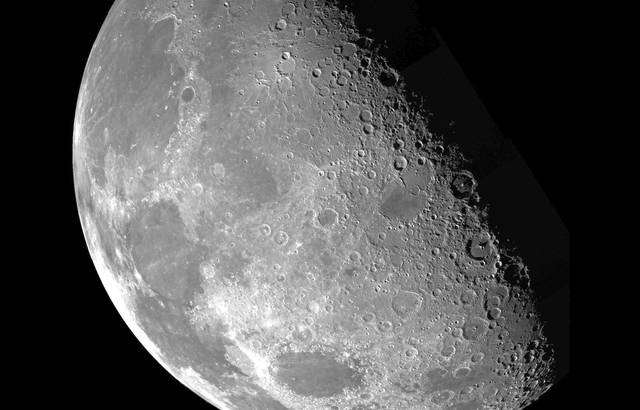NASA discovers water on moon's sunlit surface
NASA announced Monday that its Stratospheric Observatory for Infrared Astronomy (SOFIA) has confirmed water on the sunlit surface of the moon.
Officials said the finding indicates that water may be distributed across the lunar surface and not limited to cold, shadowed places.
“We had indications that H2O — the familiar water we know — might be present on the sunlit side of the Moon,” said Paul Hertz, director of the Astrophysics Division in the Science Mission Directorate at NASA Headquarters in Washington. “Now we know it is there. This discovery challenges our understanding of the lunar surface and raises intriguing questions about resources relevant for deep space exploration.”
The space agency said SOFIA — which is a Boeing 747SP airplane modified with a 106-inch diameter telescope to better see objects in space — detected water molecules in Clavius Crater, one of the largest craters visible from Earth, in the moon’s southern hemisphere.
The idea of water on the moon isn’t new. But this is the first time it’s been confirmed.
“Prior to the SOFIA observations, we knew there was some kind of hydration,” said Casey Honniball, the lead author who published the results from her graduate thesis work in the journal Nature Astronomy. “But we didn’t know how much, if any, was actually water molecules — like we drink every day — or something more like drain cleaner.
“Without a thick atmosphere, water on the sunlit lunar surface should just be lost to space,” she said. “Yet somehow we’re seeing it. Something is generating the water, and something must be trapping it there.”
Honniball did make it clear at a press conference that the study didn’t find puddles of water. Instead, she said it identified hydrogen and oxygen molecules, but that they are so distant from each other, they are neither in liquid or solid form.
While the finding is amazing, the amount of water detected in the sunlit areas of the moon wouldn’t be enough to sustain life there.
“Data from this location reveal water in concentrations of 100 to 412 parts per million — roughly equivalent to a 12-ounce bottle of water — trapped in a cubic meter of soil spread across the lunar surface,” according to a NASA press release.
NASA said the results have been published in the latest issue of Nature Astronomy.
To put it in perspective, NASA officials said the Sahara desert has 100 times the amount of water than what was detected in the lunar soil. However, scientists will no doubt be excited to study just how water is created and exists on the airless lunar surface.
“Water is a precious resource in deep space and a key ingredient of life as we know it,” NASA’s press release said. “Whether the water SOFIA found is easily accessible for use as a resource remains to be determined. Under NASA’s Artemis program, the agency is eager to learn all it can about the presence of water on the moon in advance of sending the first woman and next man to the lunar surface in 2024 and establishing a sustainable human presence there by the end of the decade.”
NASA’s upcoming Artemis program will send the first woman and next man to the lunar surface in 2024 to prepare for human exploration of Mars, which the agency said could happen as early as the 2030s.
“Understanding the science of the moon also helps piece together the broader history of the inner solar system,” NASA said.
Chris Pastrick is a TribLive digital producer. An Allegheny County native, he began working for the Valley News Dispatch in 1993 and joined the Trib in 1997. He can be reached at cpastrick@triblive.com.
Remove the ads from your TribLIVE reading experience but still support the journalists who create the content with TribLIVE Ad-Free.

